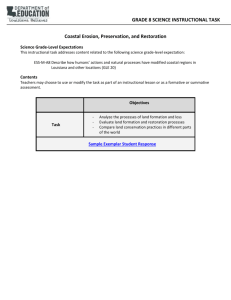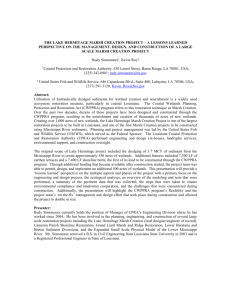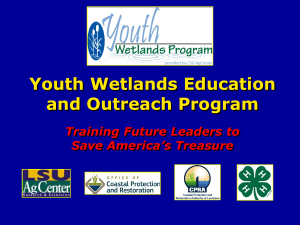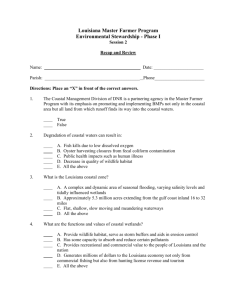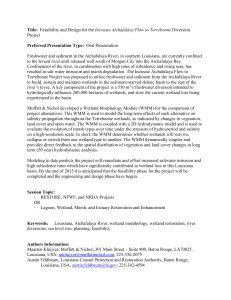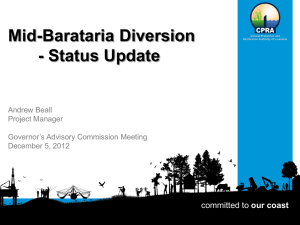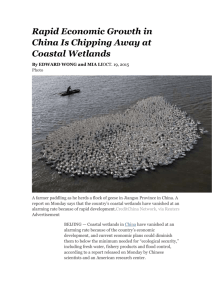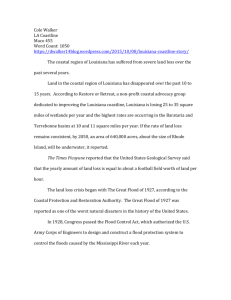Restoration technique brochure (50 pts)
advertisement
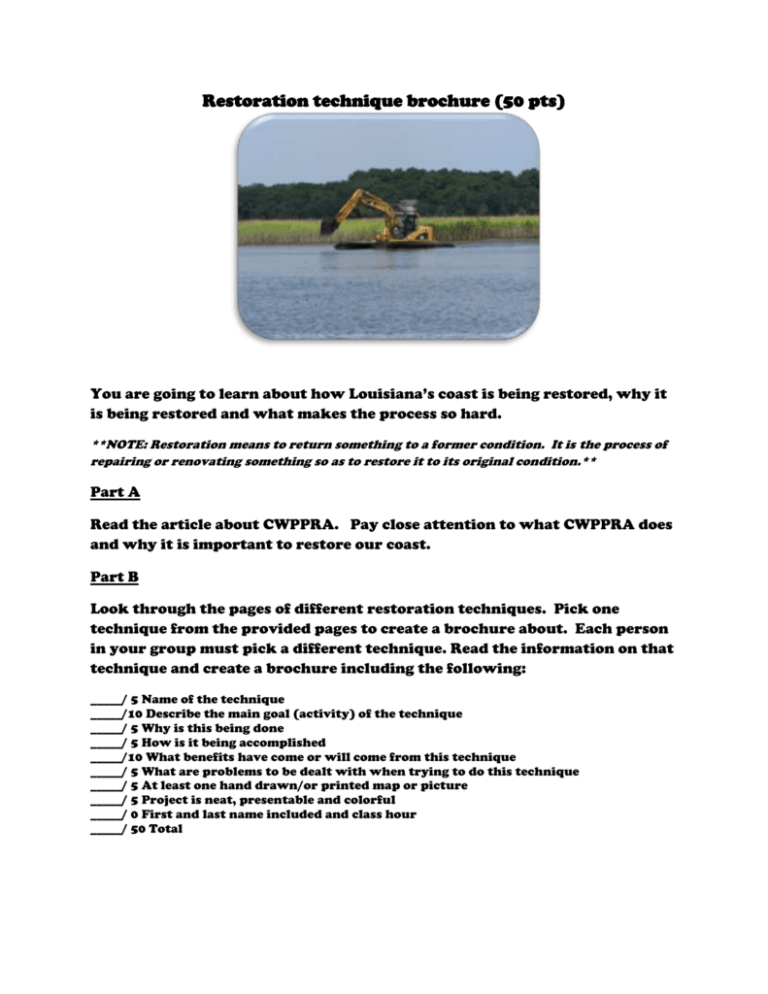
Restoration technique brochure (50 pts) You are going to learn about how Louisiana’s coast is being restored, why it is being restored and what makes the process so hard. **NOTE: Restoration means to return something to a former condition. It is the process of repairing or renovating something so as to restore it to its original condition.** Part A Read the article about CWPPRA. Pay close attention to what CWPPRA does and why it is important to restore our coast. Part B Look through the pages of different restoration techniques. Pick one technique from the provided pages to create a brochure about. Each person in your group must pick a different technique. Read the information on that technique and create a brochure including the following: _____/ 5 Name of the technique _____/10 Describe the main goal (activity) of the technique _____/ 5 Why is this being done _____/ 5 How is it being accomplished _____/10 What benefits have come or will come from this technique _____/ 5 What are problems to be dealt with when trying to do this technique _____/ 5 At least one hand drawn/or printed map or picture _____/ 5 Project is neat, presentable and colorful _____/ 0 First and last name included and class hour _____/ 50 Total The CWPPRA Legislation The Coastal Wetlands Planning, Protection and Restoration Act, (CWPPRA pronounced kwǐp-rŭh), is federal legislation enacted in 1990 that is designed to identify, prepare, and fund construction of coastal wetlands restoration projects. Since its inception, 151 coastal restoration or protection projects have been authorized, benefiting over 110,000 acres in Louisiana. The legislation (Public Law 101-646, Title III CWPPRA) was approved by the U.S. Congress and signed into law by former President George H. W. Bush. The United States Capitol in Washington D.C. Public Domain Image from the Architect of the Capitol The annual budget for CWPPRA funded restoration has varied through the nearly twenty-year life span of the Act. The budget has ranged between approximately $30 million per year to nearly $80 million per year. The funded Louisiana projects provide for the long-term conservation of wetlands and dependent fish and wildlife populations with cost-effective plans for creating, restoring, protecting, or enhancing coastal wetlands. CWPPRA Restoration Techniques CWPPRA project managers, scientists, and engineers use a variety of techniques to protect, enhance, or restore wetlands. Each restoration project may use one or more techniques to repair delicate wetlands. These techniques include: marsh creation and restoration sediment trapping shoreline protection vegetative planting hydrologic restoration barrier island restoration beneficial use of dredged material bank stabilization terracing Below is an example of the restoration technique known as the beneficial use of dredged material: CWPPRA Project BA-39 Mississippi River Sediment Delivery – Bayou Dupont Sediment is used from the Mississippi River to rebuild wetlands in a new location. The red boat near the levee is pumping sediment to the fragile wetlands in top left of the image. The sediment is then used to rebuild marsh that had turned to open water, creating new wetlands. The sediment from the river is delivered from the river to then newly created marshlands. CWPPRA Restoration Projects Since its inception, 151 coastal restoration or protection projects have been authorized, benefiting over 110,000 acres in Louisiana. To view the list of projects and learn more about individual projects visit our project page. Why Protect Louisiana Wetlands? Louisiana wetlands are unique and vital ecological assets worth saving. Wetlands act as a storm buffer against hurricanes and storms. They act as flood control devices: holding excess floodwaters during high rainfall (much like a sponge). Wetlands replenish aquifers, and they purify water by filtering out pollutants and absorbing nutrients. CWPPRA funds have been instrumental in helping to restore Louisiana’s vanishing wetlands. Approximately 40 percent of the coastal wetlands of the lower forty-eight states are located in Louisiana. Unfortunately, this fragile environment is disappearing at an alarming rate. Louisiana has lost up to 40 square miles of marsh per year for several decades – that’s 80 percent of the nation’s annual coastal wetland loss. To date, Louisiana has already lost coastal land area equal to the size of the state of Delaware. This loss is at an average rate of an acre every 38 minutes. If the current rate of loss is not slowed by the year 2040, an additional 800,000 acres of wetlands will disappear, and the Louisiana shoreline will advance inland as much as 33 miles in some areas. Download this map Wetlands also provide habitat for a variety of wildlife. Coastal Louisiana lands are the breeding grounds and nurseries for thousands of species of aquatic life, land animals, and birds of all kinds – including our national symbol, the bald eagle. This ecosystem also provides a migratory habitat for over five million waterfowl each year. A mating pair of egrets People also benefit from Louisiana’s coastal lands. Louisiana is responsible for a major part of our nation’s oil and gas production, shipping commerce, fisheries industry, fur harvesting, and oyster production, accounting for over 55,000 jobs and billions of dollars in revenues. Additionally, wetlands are wonderful recreational resources and are part of Louisiana’s growing ecotourism business. To learn more about the economic value of our wetlands, read “The Cost of Doing Nothing” in WaterMarks (Summer 1999). Example of a shrimp harvest (Photo courtesy of BTNEP) Although current funding levels do not support all of the necessary restoration required for a sustainable ecosystem, CWPPRA continues to address immediate restoration needs while establishing a foundation of strong science, public participation, and agency cooperation that will continue to serve as the cornerstone of future programs.
